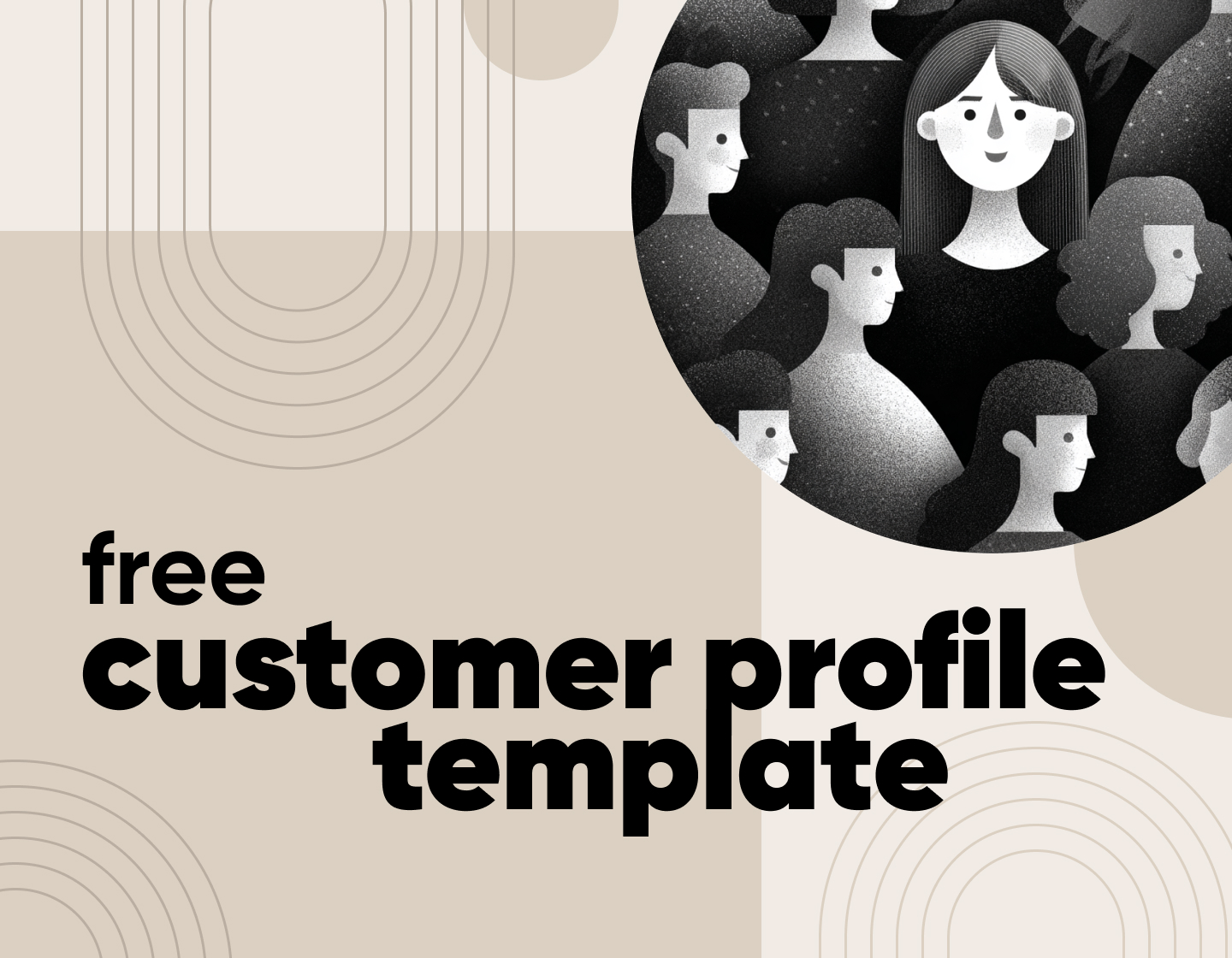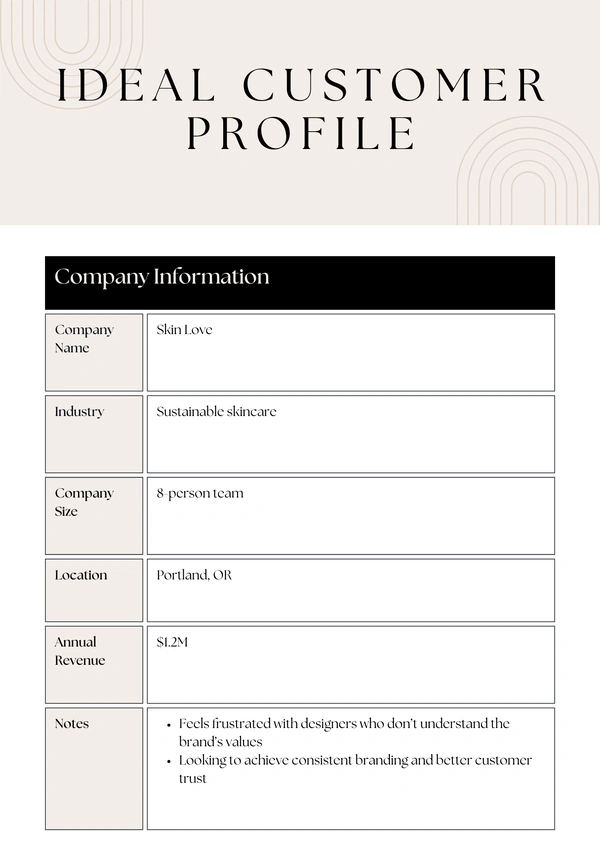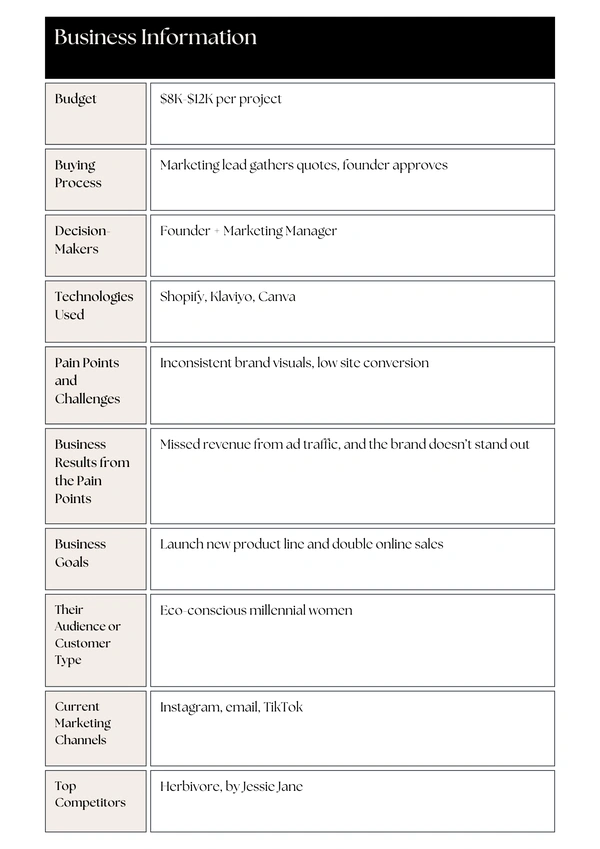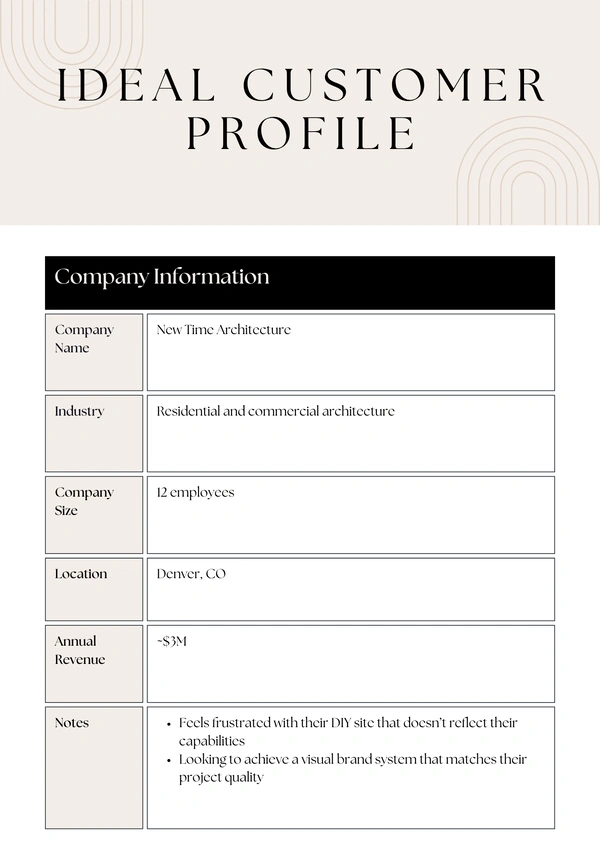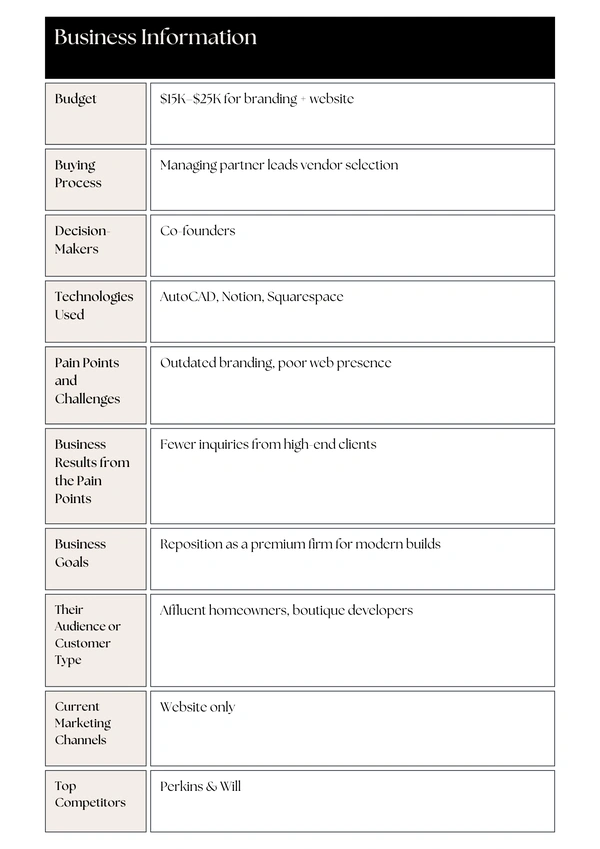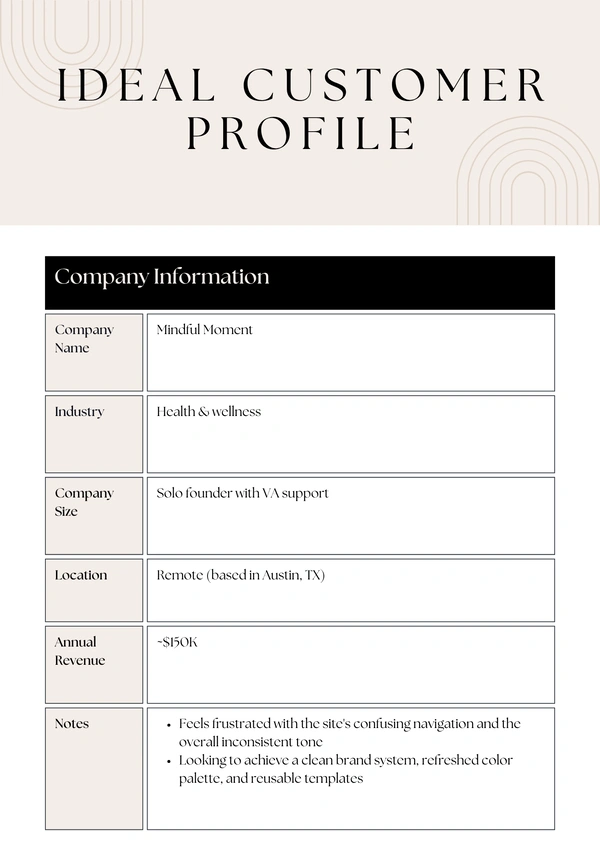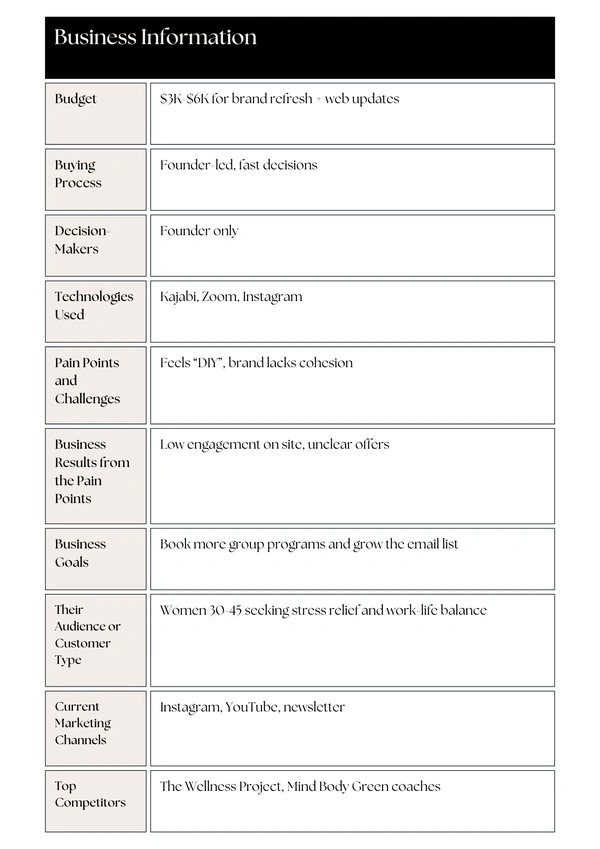Trying to guess who your dream clients are by saying yes to everyone and hoping to meet them in the process, while trying to keep things moving, is not the best way to grow your business. I’ve been there, and I feel you know it, too. That’s exactly why I created this free customer profile template, hoping to help other creative souls (like you) get clear on the types of businesses they truly want to work with.
So, wherever you are on your career path – building your first studio or simply enhancing your processes, feel free to use my customer profile template as a tool that will help you define your ideal clients in a way that’s simple, strategic, and super usable.
Now let me walk you through how it works (and why it matters). Let’s go.
Download Your Free Customer Profile Template
Here’s my free ideal customer profile template waiting to be downloaded. It’s clean, editable, and made to help you organize your thoughts clearly when you want to define your audience or get to know a client better.
What is a Customer Profile Template and Why Creative Agencies Need It?
The ideal customer profile (ICP) is one of the foundations of account-based marketing strategies. If I have to define it briefly, I’d say that a customer profile is a detailed description of the profile of your ideal type of clients, the ones you would like to have more of. These are the businesses that are the best fit for your services. To create such client profiles, you have to set specific characteristics that will describe the target market that you’re aiming at.
The ideal customer profile template’s purpose is to help you define the problems your product/service is solving and align your offerings with your customers’ needs so you get a better ROI from your marketing and sales efforts. It is also a good starting point when you want to make changes or updates to your products or services.
Now, you might be wondering how this ideal customer profile is any different from a buyer persona…
Let me put it this way: a buyer persona is more like the actual person you or your team will be getting in touch with and selling to (with demographics and psychological factors, specific customer behavior and mindset, etc), while the ideal customer profile is the general image, the type of the company these individuals represent – size, industry, goals (whether as employees or owners of the given business).
And now that we’re clear on that, let’s walk through each field of the ideal customer profile free template together. I’ll show you what each one means and how to fill it out so it helps you create a more effective and targeted marketing strategy.
Filling Out The Ideal Customer Profile Template: Section-by-Section Breakdown
Now that you know what a customer profile is and why it matters, let’s walk through each part of the template. This will help you fill it in with confidence and effectively put it to use in your process.
1. Company Information
This section helps you get a more precise picture of the business. It’s a great starting point to quickly assess if the company fits within your niche, values, and capacity, and whether they’re the kind of client you want to attract more of.
1.1. Company Name:
Keep track of who you’re profiling, especially if you’re using the template for real leads or case study examples. For fictional profiles, give the business a name that captures the kind of client you’re aiming for, as it helps you visualize them more clearly.
1.2. Industry:
Knowing what industry they’re in helps you speak their language, predict their needs, and shape your messaging. If you work mostly with creative entrepreneurs or tech startups, this is where you define that focus.
1.3. Company Size:
This gives you insight into how big the team is and what kind of internal structure they might have. A solo founder will have different needs (and timelines) than a 30-person company with a marketing department. It also influences the complexity and scope of your projects.
1.4. Location:
Time zones and regions matter more than we think. A business based in your country might be easier to coordinate with, while international clients may bring cultural and logistical nuances worth noting. This field helps you predict those dynamics.
1.5. Annual Revenue:
This field of the customer profile template is optional, but it can help you measure the business’s stage of growth and potential budget. You don’t need exact numbers; listing ranges is absolutely fine (for example, under $500K, $1M to $5M, etc).
1.6. Notes:
Use this space for anything that doesn’t fit neatly into the other fields but still paints a useful picture. For example, you might take notes on the company’s tone of voice, what their branding feels like, their online presence, or even a gut feeling about whether they’re a fit.
2. Business Information
This section goes deeper into how the business operates, makes decisions, and what it’s aiming to achieve. It gives you the context you need to understand if and how you can truly help them. This is where strategy starts to take shape.
2.1. Budget:
Knowing what they can invest helps you scope your services realistically and decide whether this is a client worth pursuing. You don’t need exact numbers, just a general range, or their usual spend on design/branding/whatever-you-offer work is enough to give you direction.
2.2. Buying Process:
Some clients move fast, others need multiple approvals and weeks to decide. Understanding how their decision-making works helps you plan timelines and avoid blockages. For example, are you speaking directly with the owner, or are you pitching to someone who needs to get a sign-off from a board?
2.3. Decision Makers:
This field of the customer profile template is about identifying who’s the one making the calls. It could be a founder, a head of marketing, or even a small team. Knowing this helps you tailor your communication and make sure you’re talking to the right people.
2.4. Technologies Used:
This is especially useful for web designers and digital creatives. What platforms are they already using? Shopify, Webflow, HubSpot? The tools they’re comfortable with (or struggling with) will impact how you design solutions and how smoothly your work fits into their systems.
2.5. Pain Points and Challenges:
What’s not working for them right now? Maybe they need a brand refresh because it feels outdated, or their site is hard to navigate, or they’re not attracting the right clients. Listing these challenges helps you see where your services can make the biggest impact.
2.6. Business Results from the Pain Points:
Go one step further than just the problems and think about what effect those issues are having on their business. Are they losing leads? Missing their goals? Spending too much time fixing things? This connects your work to real business value.
2.7. Business Goals:
What are they working toward? A rebrand, a product launch, or expanding to a new market? Knowing their goals helps you align your creative work with their bigger picture and speak to what matters most to them.
2.8. Target Audience or Customer Type:
Who are they trying to reach? Are they targeting startups, corporate clients, or Gen Z creators? This helps you shape the visuals, tone, and user experience to match the needs and preferences of their end customers.
2.9. Current Marketing Channels:
Where are they showing up now? This helps you identify what’s working, what’s missing, and how your services can support or enhance their efforts.
2.10. Top Competitors:
Knowing who they’re up against gives you an edge when it comes to differentiation. This info can inspire design choices, tone direction, and even help you position them more clearly in the market.
And now, with all these fields filled out, you’ll have a clear, strategic snapshot of the kind of clients who are the best fit for your creative business.
Real-Life Examples for Filling Out the Customer Profile Template
Here I share a few example profiles of different types of clients you might work with. Still, these aren’t full templates, but just a snapshot with brief descriptions of customer data to make things clearer and show how the fields come together in real life.
• Example 1: Small eCommerce Brand Scaling Up
- Company Name: Skin Love
- Industry: Sustainable skincare
- Company Size: 8-person team
- Location: Portland, OR
- Annual Revenue: $1.2M
- Budget: $8K-$12K per project
- Buying Process: Marketing lead gathers quotes, founder approves
- Decision Makers: Founder + Marketing Manager
- Technologies Used: Shopify, Klaviyo, Canva
- Pain Points and Challenges: Inconsistent brand visuals, low site conversion
- Business Results from the Pain Points: Missed revenue from ad traffic, and the brand doesn’t stand out
- Business Goals: Launch new product line and double online sales
- Audience or Customer Type: Eco-conscious millennial women
- Current Marketing Channels: Instagram, email, TikTok
- Top Competitors: Herbivore, by Jessie Jane
• Example 2: Local Service Provider (Architecture Firm)
- Company Name: New Time Architecture
- Industry: Residential and commercial architecture
- Company Size: 12 employees
- Location: Denver, CO
- Annual Revenue: ~$3M
- Budget: $15K-$25K for branding + website
- Buying Process: Managing partner leads vendor selection
- Decision Makers: Co-founders
- Technologies Used: AutoCAD, Notion, Squarespace
- Pain Points and Challenges: Outdated branding, poor web presence
- Business Results from the Pain Points: Fewer inquiries from high-end clients
- Business Goals: Reposition as a premium firm for modern builds
- Audience or Customer Type: Affluent homeowners, boutique developers
- Current Marketing Channels: Website only
- Top Competitors: Perkins & Will
• Example 3: A Wellness Coach Selling Services Online
- Company Name: Mindful Moment
- Industry: Health & wellness
- Company Size: Solo founder with VA support
- Location: Remote (based in Austin, TX)
- Annual Revenue: ~$150K
- Budget: $3K-$6K for brand refresh + web updates
- Buying Process: Founder-led, fast decisions
- Decision Makers: Founder only
- Technologies Used: Kajabi, Zoom, Instagram
- Pain Points and Challenges: Feels “DIY”, brand lacks cohesion
- Business Results from the Pain Points: Low engagement on site, unclear offers
- Business Goals: Book more group programs and grow the email list
- Audience or Customer Type: Women 30-45 seeking stress relief and work-life balance
- Current Marketing Channels: Instagram, YouTube, newsletter
- Top Competitors: The Wellness Project, Mind Body Green coaches
How to Use the Customer Profile in Your Workflow
Don’t think you’re done once you’ve filled out the profile, because the real magic is in how you use it. This isn’t solely a document to check off and forget. It is a reference point you can keep coming back to as you grow, refine your services, connect with the right people, and create effective campaigns.
Here are some tips and best practices:
- Define your ideal client before launching your site or outreach.
Instead of fishing for all the creatures in the sea, use the ideal customer profile template to get super specific about who you’re talking to. This helps shape your website messaging, visuals, and even your case study examples. - Guide decisions about your portfolio, service packages, and pricing.
The clearer you are about your target clients, the easier it becomes to design offers that match their needs and budget without second-guessing yourself. - Use the customer profile template during client discovery to better understand who you’re working with.
You can adapt the template as a conversation guide. It helps you ask more strategic questions and pick up on red flags or alignment early on. - Keep a few profiles on hand to spot patterns among best-fit clients.
As you work with more clients, you’ll certainly start to notice similarities. These patterns can shape your niche, your process, and how you present your value. - Revisit and refine it as your agency grows and evolves.
Your ideal client might shift over time, and that’s completely normal. It also means revisiting your profile at least once a year or sooner if you are making any changes in your offerings. You can even set a reminder (once or twice a year) to review and update your target customer profile to keep your marketing and positioning aligned.
Bottom line
Getting clear on who you want to work with isn’t just a branding exercise but a great, smart move that saves time, builds confidence, and helps your creative work hit the mark. Having a solid customer profile gives you direction and clarity at every step.
So, are you ready to make this a part of your process?
Then go ahead and download the free customer profile template if you haven’t already, and start shaping your studio around the clients who truly fit.
But before you run off to conquer your ideal clients, check out our other articles full of useful resources and helpful tips:


